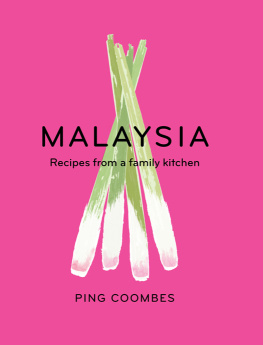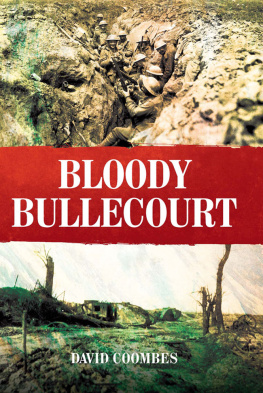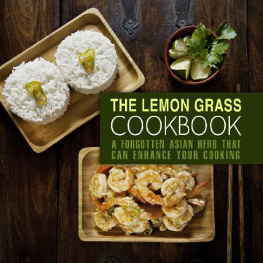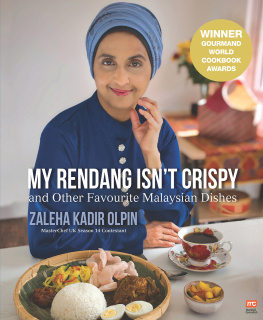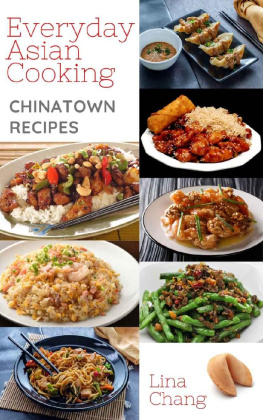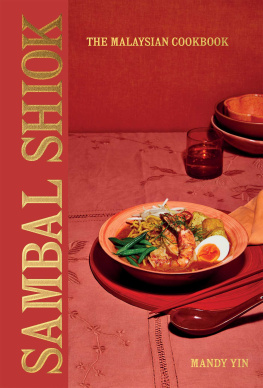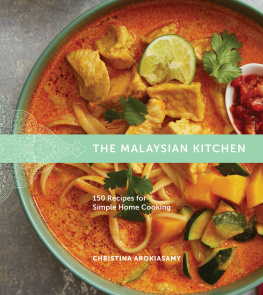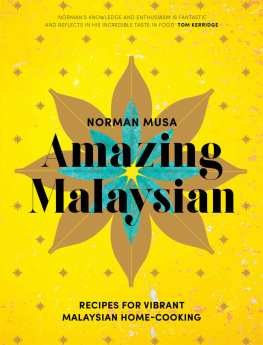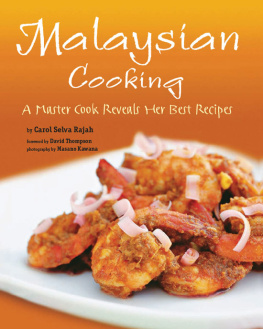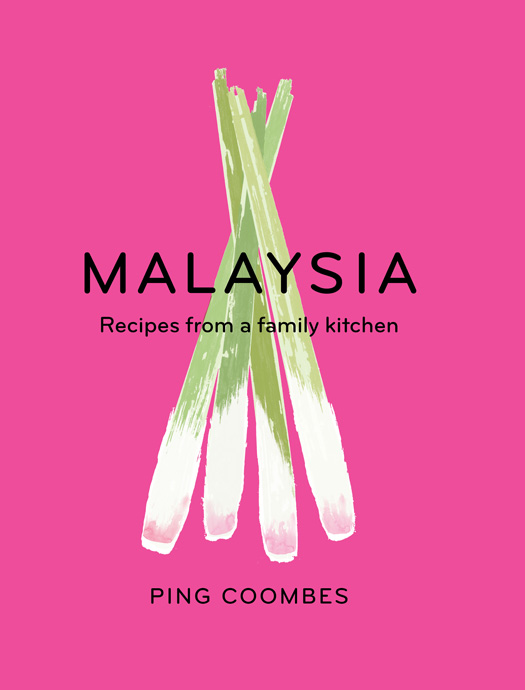
To my mum, who taught me what good food is; to Alexa, my daughter, who inspires me to be a better cook every day; and to my husband, Andrew, who supports and loves me unconditionally.
Food has the power to create and evoke memories.

INTRODUCTION
Hello, Im Ping! In addition to being wife to my long-suffering husband, Andrew, and mother to my beautiful, cheeky daughter, Alexa, my obsession in life is spreading the love for Malaysian food and flavors. Im so passionate about Malaysian food, I entered MasterChef 2014 so that I could get the word out about this wonderful cuisine from my home country. And I won! This book is so precious to me, as each dish is created with memories from my childhood and interwoven are pieces of my familys history, my travels, and my love of food. I want to show you just how easy, joyful, and delicious Malaysian food can be.
MY MALAYSIA
I grew up in Malaysia, in a city called Ipoh famous for its limestone caves, pomelo, bean sprouts, and women. Women, I hear you say? Yes legend has it that the limestone mountains around Ipoh protect the purity of the air and water; therefore, Ipoh women are more beautiful than anywhere else in Malaysia.
My mum did most of the cooking at home, and when she was working, my grandmother (Popo) would take over. My grandmother migrated to Malaysia from China when my dad was just a few days old, and she brought with her the influences of Hakka cooking a cuisine from northern China that often features preserved pork and vegetables.
When I wasnt tearing around the neighborhood on my bicycle, or fighting with my brother, I would stand in the kitchen to watch Mum cook. There was always a wok, a soup pot, and a rice cooker on the go. My mum would rise early in the morning, visit the local wet market, come home, put a soup over low heat on the charcoal burner outside, then go to work. We would wake up to the sweet smell of soy-braised pork belly and fragrant chicken broth wafting through the house. It would simmer gently all day so that when she came home from work, all she would have to do is add the finishing touches.
Watching my mum cook was mesmerizing: she knew exactly what to put in there were no scales or measuring spoons in sight and she was always so quick.
Every evening, my mum would call out for us: Ping, Boy! (my brothers nickname) Sek fan la! (meaning come eat your dinner). The first thing wed be met with would be the intoxicating smell, followed by the sight of a sumptuous feast of at least three different dishes and a broth.
Occasionally my mum would attempt what she called English food, which included a kind of Asian spaghetti bolognese, her infamous chicken pies, and stews with potatoes and star anise. Despite her dubious interpretations of Western food, I loved all these dishes, and it felt like such a novelty to be eating something different from our usual staples. In light of this, Ive included a chapter on English food to pay tribute to my mums delicious experimental recipes.
It was only in my early twenties, when I came to the United Kingdom to go to university, that I started to cook for myself.
I go back to Malaysia every year to visit family and friends, and every trip revolves around food. Throughout the year, Andrew and I make a list of what we want to eat on our upcoming trip, and tick them off as we go along: our list might consist of satay sweet and smoky strips of meat grilled to order and served with spicy peanut sauce; nasi lemak coconut rice with sambal ikan bilis , my winning main course on MasterChef; and soft chicken hor fun noodles in Ipoh Old Town, where I ate as a child and recently took Alexa. These for me are the tastes and aromas of home, which I hope Ive captured in this book.
MALAYSIA ON A PLATE
So, what is Malaysian food? Good question! I was once asked in an interview why Malaysian food is relatively unknown in the UK compared to Thai or Japanese. I gave it some thought and realized the answer isnt straightforward. To understand Malaysian food is to understand how Malaysia is made up. The country consists largely of three races: Malays, Chinese, and Indians. Imagine the array of flavors and influences just from these three cultures. Its difficult to pinpoint one distinct dish or flavor and call it Malaysian, as Malaysian cuisine is a fusion of all these cultures.
prawns cooked in a tangy lemongrass and chili sauce.
Then there is the Malaysian Mamak fare. Mamak is the name for the Indian Muslim community in Malaysia. Mamak street-food stalls look pretty basic, with stainless-steel tables, and they stay open until late at night some are even open twenty-four hours a day. They serve up dishes like fried noodles with a spicy, sweet, and sticky sauce.
Malaysian food to me is just so exciting, with its almost never-ending variation of flavors, textures, and smells. I want to show you how easy it is to re-create the flavors I grew up with, using ingredients easily sourced in your local supermarkets. I also tell you how to store and use ingredients in different ways so that nothing goes to waste, and most of the recipes do not require much preparation or a long, daunting list of ingredients. A few require a little effort, but I promise you its worthwhile.
I hope this book will entice you to discover this hidden gem of a cuisine. Most importantly, I want you to have fun making the dishes and to put a smile on the faces of the people you cook for. Every recipe has its own story and in each there is an expression of sharing love through food. Id like to share all of this with you.
Happy cooking and happy eating


MY PANTRY
Not long ago, a friend took one look at my little pantry and said, It looks like an Asian supermarket in there! She was completely fascinated by the rows of ingredients in their glass jars, ranging from shiitake mushrooms and dried shrimp to dried chilies.
To create Malaysian dishes at home, I always have these ingredients on hand, either in the fridge, the freezer, or the pantry. Here I have included ways of storing them where applicable, so that you can stretch them that much further and avoid waste. You can find all of these ingredients in your local supermarket or Asian grocery.

HERBS, LEAVES, STEMS, AND BUDS
1. CILANTRO
A fragrant herb used a lot in Southeast Asian cooking. It is particularly great with curries, stir-fries, and fritters. Leftover cilantro can be frozen.
2. CURRY LEAVES
This potent herb is commonly used to flavor curries. It is often found dry in the herb section of the supermarket, but I always use fresh leaves, which you can find in a lot of Indian shops. Buy a big bunch, remove the leaves, and place them in a freezer bag. Freeze, and when youre ready to use them, just drop them into curries straight from the freezer.
3. KAFFIR LIME LEAVES

